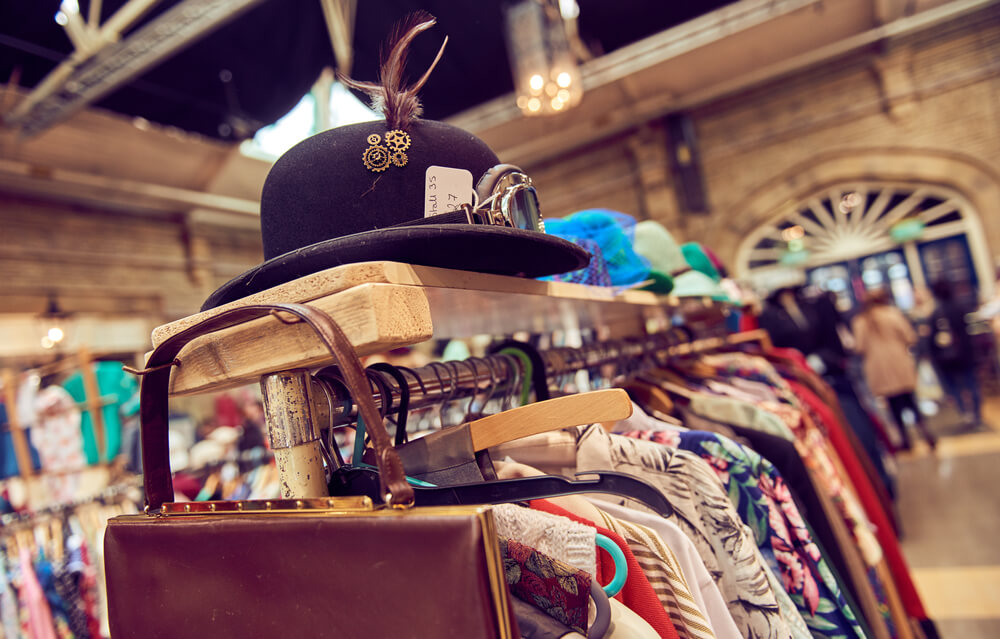We honestly can’t think of a more opportune time to talk about STUFF than right now, as we head into the thick of the holidays, wading through piles and piles of joy, cheer, and more stuff.
Why do we call it *stuff* anyway? Is it because we must figure out how to stuff it into spaces?
It doesn’t matter. The point is that it’s an excellent time to really feel what it might be like to live inside a landfill. And then subsequently, to question whether or not consumption could be done another way.
Enter: Second-hand consumption!
Thrifting and second-hand shopping are nothing new, of course; people have been thrifting since the Great Depression and likely even earlier, especially during leaner times. What’s new is this glorious renaissance it’s experiencing, as second-hand increasingly becomes more of a choice than a necessity, shedding any perceived stigma.
According to data from Statista Consumer Insights, as many as 60% of respondents in the U.S. said they’ve made at least one second-hand purchase in the past year, up from 49% in 2019 – a sentiment that’s being echoed internationally.
From the same survey, the value of the worldwide second-hand apparel market is forecast to hit $84 billion by 2030, which would mark a jump of $56 billion in just a decade. Statista analysts say that at this rate, fast fashion may soon be outpaced by the second-hand fashion market.
But wait, hold on a sec, rewind – what’s fast fashion?
Real quick: Before the advent of cheaper, mass produced apparel (think: H&M, Zara, Shein, Forever 21, etc…), clothes were handmade with individually-sourced materials. Up until the 60s, fashion was, for all intents and purposes, “slow.”
But the term “fast fashion” wasn’t coined until about 30 years later by the New York Times to describe Zara’s new, accelerated production model. Other brands quickly followed suit to offer up a cheap, easy way to keep up-to-date on trends within the whirlwind world of fashion. In 2022 alone, China-based Shein was the most downloaded fashion app, and the most visited fashion site globally.
So, what’s the downside?
Ok, how much time (and space) do you have…
Shein specifically churns out the same amount of CO2 as approximately 180 coal-fired power plants, according to a fashion sustainability report. As a result, the company releases about 6.3 million tons of carbon dioxide a year.
Put simply, none of this is even remotely sustainable, and we’re not just talking about clothes, anymore. The take-make-waste production model transcends the fashion industry, contributing to progressively more waste than ever before. You know how stressed you feel this time of year? Imagine how the planet feels!
On top of this, fast fashion and similarly wasteful industries are often associated with exploitative labour conditions, depending on the country of origin, and mysteriously opaque supply chains.
On the other hand, second-hand can help support the transition to a circular economy – by extending the lifespan of products, and ultimately, redefining both waste and growth in an effort to reduce our environmental footprint.
In fact, there is a burgeoning “re-commerce” ecosystem emerging, where big brands such as Patagonia, MEC, and even H&M are selling previously owned, premium quality items back to consumers, redirecting goods back into the marketplace and diverting them from landfills in the process.
This is good news. But not unlike a landfill, it’s a lot of stuff to take in.
For your convenience, here’s a compact li’l summary to refer to when considering the benefits of buying second-hand:
- Prettier prices
- minimal packaging
- supporting local
- and just generally not stressing out the environment nearly as much.
So, as you wonder where all the available surface area in your home went, remember: All is not lost! Even though it physically appears that way! 2024 can be the year where we experiment with more second-hand purchases. It can be the year we contribute to a circular economy when possible. It can even be the year we try reusable fabric gift wrap, a real thing that exists!
And with that said, I think that’s a wrap on stuff.
Happy Holidays, everyone! All the best for a fantastic 2024.

